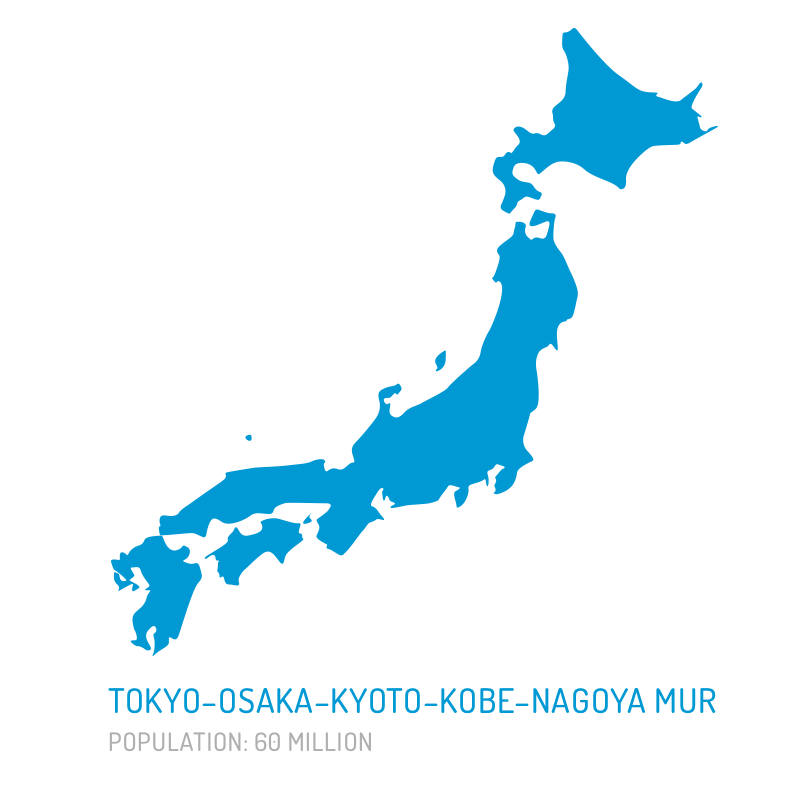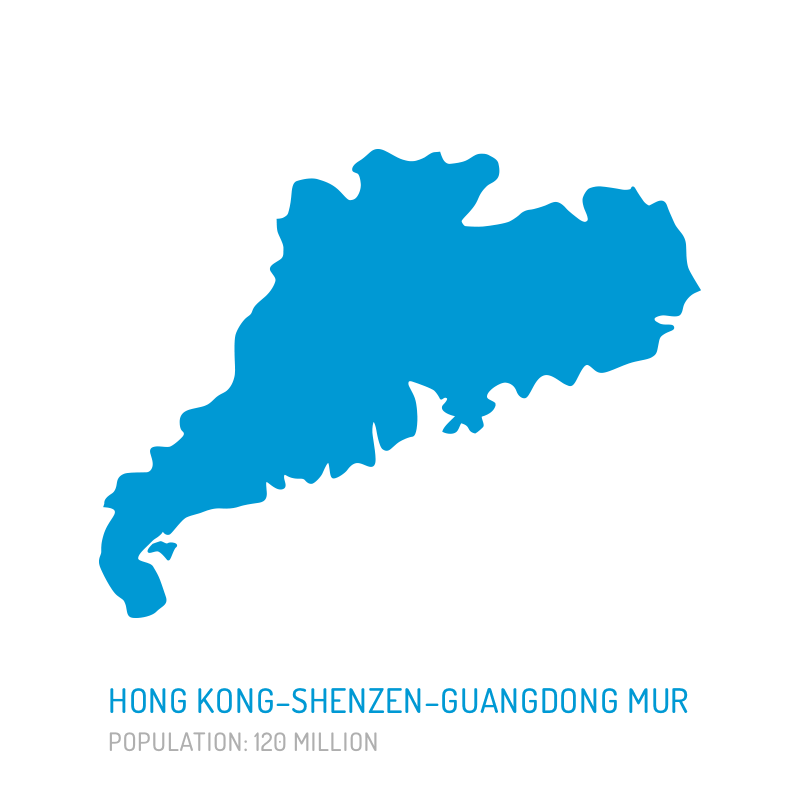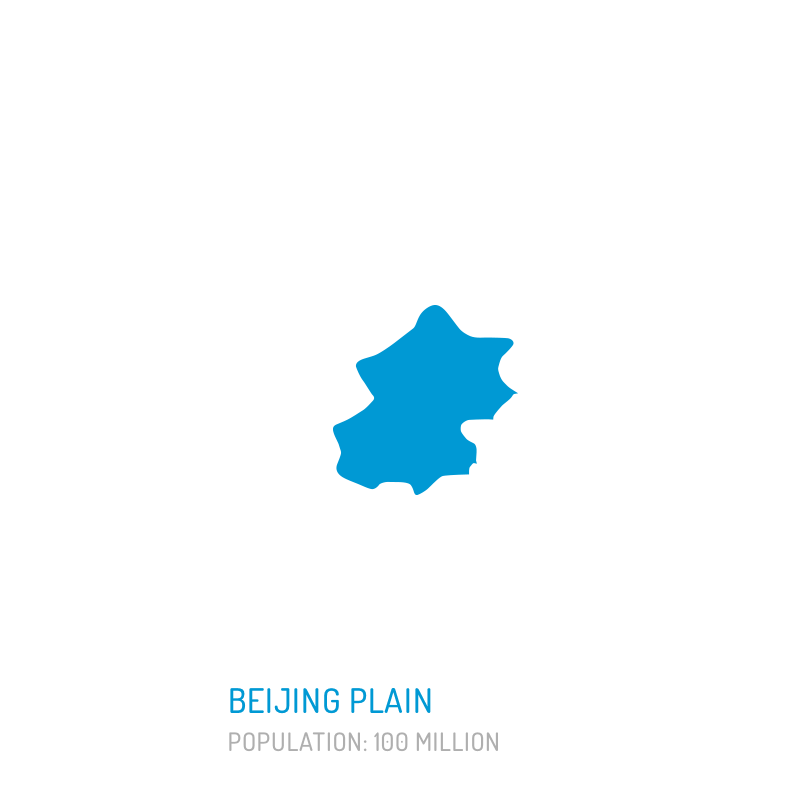The size of Asia's cities by the middle of the Asian Century will likely dwarf anything city planners ever thought possible.
Imagine an urban agglomeration stretching from Beijing in the North all the way down coastal China, into the Mekong and down Vietnam up to Bangkok and then all the way south through Malaysia and Singapore before extending east along the Indonesian archipelago. This urban sprawl is likely to be home to over one billion people and stretch nearly 12,000 kilometres. Inner-city living in this Ecumenopolis? We'd estimate it would be located just to the north-west of Ho Chi Minh City in Vietnam and to the south-west of Vientiane in Laos. Convenient for a good Phở Bò but quite the commute for Peking Duck or Nasi Goreng.
Asia's Megolopolis will come into being largely as a result of the fusion of a number of mega-urban regions (MURs) along the Asian-Pacific seaboard. Lets start with a North-South consideration to begin with.
Over the next 10 years we would envisage two thirds of the urban population of the ASEAN will live in only five mega-urban regions.
ASEAN's mega-urban regions

The Southeast Asian MUR's are likely to have a combined population of nearly 200 million people. As impressive as this sounds, the southeast Asian MUR's will be country towns compared with the giants coalescing in north Asia – cities that even as populations peak, simply do not stop growing!
Southeast Asian MURs will be relatively small compared with those in north-east Asia where at least five giant MURs will coalesce.
North-east Asia's mega-urban regions




The metrics here are simply mind blowing – in both of terms of physical size, density and likely population. According to the French Institute of Demographic Studies, by 2050 the population of Asia is expected to be 5.2 billion people accounting for roughly half the world's 10-11 billion population at the time.
Around the same time, it is estimated around 66 per cent of the Asian population will be urbanised. That is, by 2050, we can expect 2.6 billion people in Asia will be living in cities or, as we have suggested, in one Asian mega-urban region. How big will that city physically be? International comparisons suggest it will be of an incomprehensible size.
Whereas the average population density of the BoWash belt on North East US coast is 450 people per square kilometre, Asian cities have typically grown with much tighter population densities. Population density can range from 400 to 500 people pskm in the Philippines and parts of Thailand, to around 700-750 people pskm in southern and western India to around 1000 people in Java and a staggering 1500 in the Taiheiyo Belt.
Asia's urban population of 2.6 billion people would thus require urban areas as large as 2.6 million square kilometres with a population density of Java.
"If the urban population of Asia was to live in a single city, Asiaopolis, with the population density of Sydney, then Asiaopolis would entirely take up all of continental Australia."
With that visual in mind, we start to get some idea of how the urbanisation of Asia will impact economies like Australia and New Zealand and the rest of the world. Australia and New Zealand have enjoyed enormous benefit from the industrialisation of China to date – a process which is already transforming and on which most Australian observers appear negatively fixated. China may well prove to be the appetiser for what is the main-course of broader Asian urbanisation. Metropolis Now. Ecunopolis in the next two-to-three decades. It all suggests the bounty for an economy like Australia is almost unimaginable.
The questions that come to my mind almost immediately are:
Who will and how will the construction and development of a mega-city this size be financed?
Asia's continental city implies huge increases in energy consumption and carbon emissions. Is this sustainable?
How will the work/life balance change in a city this large where, surely, commuting becomes impossible?
How will the work/life balance change in a city this large where, surely, commuting becomes impossible?
The Infrastructure and investment required in the next four decades in the construction of such a mega-urban region are almost unimaginable. The requirement for co-ordination across borders will be immense and involve a sense of civic planning on a regional level that has not yet developed in some economies on a basic country specific level. With these ongoing patterns of urbanisation already in play across both north and south Asia, we see Asiaopolis as having three defining characteristics differentiating it from every other great city civilisation has known.
1. Enormous total population
2. Vast geographic size
3. The speed at which it has formed
These three characteristics are not static. In fact their dynamic interplay will give further colour to what we can expect Asiaopolis to look like and function. The interplay of points 1 and 2 mean population density will need to be carefully managed. The interplay of points 2 and 3 mean investment in infrastructure and public transport may not be able to keep up with the growth of Asiaopolis.
In a negative scenario, vast slum areas may form home to hundreds of millions of people. In the positive scenario, radical new efficiencies will be discovered in energy usage and de-carbonised growth while disruptive digital technology will be fundamentally embraced to negate the construction of physical infrastructure such as regional branch networks of banks, libraries, government offices and other services. Asiaopolis will require urban planning co-ordinated across countries and an unprecedented degree of synchronisation of technologies such as bullet trains that run country to country with seamless border and customs control.
What will the Boroughs or Suburbs of Asiaopolis be like?
As we start our journey south from Beijing, we are likely to move into the more middle income Fujian Plain and as we head further south we'll reach what is likely to be the geographical centre of Asiaopolis, somewhere around Vientiane in Laos or Ho Chi Minh City in Vietnam. Interestingly, given its strong endowment of electricity from harnessing the Mekong, Laos is likely to remain the "battery" of Asiaopolis and manufacturing platforms are likely to be an inner-western city phenomenon stretching from South Vietnam, through Laos, Cambodia and into Myanmar.
The East-West Axis
The east-west distribution of Asiaopolis will be no less fascinating. Vietnam is likely to have emerged as an advanced manufacturing hub, distributing technologically advanced goods, many of which have not been invented yet, from its long eastern seaboard which will have developed into an incredibly sophisticated logistics, shipping and distribution hub. And then there is the link to the Philippines archipelago - a massive mega-urban region in its own right. Its geographical separation from the land based Southeast Asian continent is likely to see the Philippines retain its role as the services hub and centre of Asia.
The challenges of physically connecting the 7,000 islands of the Philippines archipelago will clearly see the Philippines rely on "digital" connectivity and the Philippines could therefore emerge as the Silicon Valley type region of the Asiaopolis. The western suburbs of Asiaopolis will be defined by three of the world's largest urban agglomerations, Mumbai, Delhi and Dhaka. Again with India's specialisation in services, we can see satellite services hubs emerging around the manufacturing centre to both the east and west of south east Asia.
Wrapping up
The historical role and efficiency of Cities in determining the quality and quantity of economic growth will be fundamental to Asia's megalopolis determining Asia's growth. Asia's cities already account for around 80 per cent of economic output. Historically cities have always been key drivers of both the quantity and quality of growth given they are centre of higher education, innovation and technological development.
The quality and efficiency of the mega-urban regions will ultimately determine Asia's long term growth potential and competitiveness as well as political and social stability. To the extent a "critical mass" of population in cities has often been a trigger for "giant leap" technological innovations, Asia's mega-urban region can be expected to develop into a hotbed of innovation and invention if governments use the efficiencies of scale urbanisation offers to invest in technology.
Though the formation of a mega-city in Asia will present significant and deep challenges such as the avoidance of slums, transport congestion and pollution, the simplest and most positive outcome could well be the giant Asian city of the future will be a centre of innovation and excellence that will finally dispense with the moniker of Asia as an imitator not an innovator.










